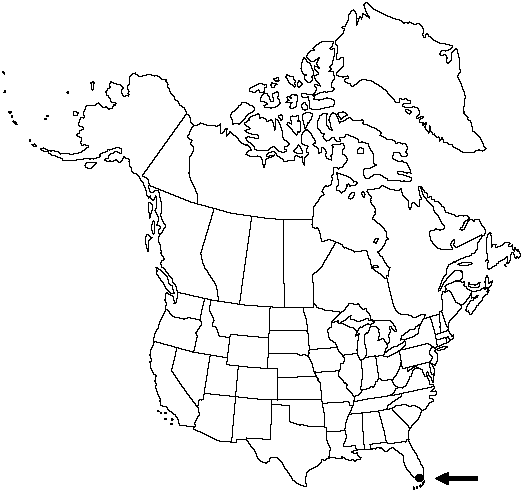Difference between revisions of "Asplenium ×biscayneanum"
Fern Bull. 12: 45. 1904.
FNA>Volume Importer |
FNA>Volume Importer |
(No difference)
| |
Revision as of 18:55, 24 September 2019
Roots proliferous. Stems erect, not branched; scales blackish throughout, linear-deltate, sparse, 1–1.3 × 0.1–2.4 mm, margins entire. Leaves nearly monomorphic. Petiole green, becoming blackish in older leaves, 1–5(–12) cm, 1/8–1/3 length of blade; indument of black, narrowly lanceolate scales. Blade dull, linear, 2-pinnate, (4–)12–22 × 1–3.5 cm, papery, glabrous; base slightly tapered; apex narrowing gradually, not rooting. Rachis mostly blackish, green distally and in juvenile leaves, shiny, sparsely scaly. Pinnae in 9–20 pairs, oblong, 0.5–2 × 0.4–1.3 cm; apex blunt to truncate. Pinnules of 1–2 segments; segments linear-oblong, 3–6 × 1–3 mm; margins dentate; apex notched, pointed, rounded, or blunt. Veins free, evident. Sori 1–2 per segment, on both basiscopic and acroscopic sides. Spores abortive. 2n = ca. 180.
Habitat: Hammocks, on limestone rock faces
Elevation: 0–20 m
Discussion
Asplenium × biscayneanum is the hybrid of A. trichomanes-dentatum and A. verecundum, with which it occurs. This peculiar spleenwort may most readily be separated from A. trichomanes-dentatum by its deeply cut pinnae, and from A. verecundum by being only 2-pinnate and having long petioles. Chromosome pairing in A. × biscayneanum is irregular. Judging from herbarium collections, it shows considerable hybrid vigor. All the collections are from Dade County, Florida, where it may now be extirpated.
Selected References
None.
